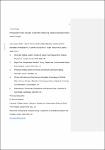Perioperative redox changes in patients undergoing hepato-pancreatico-biliary cancer surgery
| dc.contributor.author | Stevens, JL | |
| dc.contributor.author | McKenna, HT | |
| dc.contributor.author | Filipe, H | |
| dc.contributor.author | Lau, L | |
| dc.contributor.author | Fernandez, BO | |
| dc.contributor.author | Murray, AJ | |
| dc.contributor.author | Feelisch, M | |
| dc.contributor.author | Martin, DS | |
| dc.date.accessioned | 2023-08-08T09:35:51Z | |
| dc.date.available | 2023-08-08T09:35:51Z | |
| dc.date.issued | 2023-07-10 | |
| dc.identifier.issn | 2047-0525 | |
| dc.identifier.issn | 2047-0525 | |
| dc.identifier.other | 35 | |
| dc.identifier.uri | https://pearl.plymouth.ac.uk/handle/10026.1/21179 | |
| dc.description.abstract |
Abstract Background Tissue injury induces inflammation and the surgical stress response, which are thought to be central to the orchestration of recovery or deterioration after surgery. Enhanced formation of reactive oxygen and nitrogen species accompanies the inflammatory response and triggers separate but integrated reduction/oxidation (redox) pathways that lead to oxidative and/or nitrosative stress (ONS). Quantitative information on ONS in the perioperative period is scarce. This single-centre exploratory study investigated the effects of major surgery on ONS and systemic redox status and their potential associations with postoperative morbidity. Methods Blood was collected from 56 patients at baseline, end of surgery (EoS) and the first postoperative day (day-1). Postoperative morbidity was recorded using the Clavien-Dindo classification and further categorised into minor, moderate and severe. Plasma/serum measures included markers of lipid oxidation (thiobarbituric acid-reactive substances; TBARS, 4-hydroxynonenal; 4-HNE, 8-iso-prostaglandin F2⍺; 8-isoprostanes). Total reducing capacity was measured using total free thiols (TFTs) and ferric-reducing ability of plasma (FRAP). Nitric oxide (NO) formation/metabolism was measured using cyclic guanosine monophosphate (cGMP), nitrite, nitrate and total nitroso-species (RxNO). Interleukin-6 (IL-6) and tumour necrosis factor alpha (TNF-⍺) were measured to evaluate inflammation. Results Both oxidative stress (TBARS) and nitrosative stress (total nitroso-species) increased from baseline to EoS (+14%, P = 0.003 and +138%, P < 0.001, respectively), along with an increase in overall reducing capacity (+9%, P = 0.03) at EoS and protein-adjusted total free thiols (+12%, P = 0.001) at day-1 after surgery. Nitrite, nitrate and cGMP concentrations declined concomitantly from baseline to day-1. Baseline nitrate was 60% higher in the minor morbidity group compared to severe (P = 0.003). The increase in intraoperative TBARS was greater in severe compared to minor morbidity (P = 0.01). The decline in intraoperative nitrate was more marked in the minor morbidity group compared to severe (P < 0.001), whereas the cGMP decline was greatest in the severe morbidity group (P = 0.006). Conclusion In patients undergoing major HPB surgery, intraoperative oxidative and nitrosative stress increased, with a concomitant increase in reductive capacity. Baseline nitrate was inversely associated with postoperative morbidity, and the hallmarks of poor postoperative outcome include changes in both oxidative stress and NO metabolism. | |
| dc.format.extent | 35- | |
| dc.format.medium | Electronic | |
| dc.language | en | |
| dc.publisher | Springer Science and Business Media LLC | |
| dc.subject | Morbidity | |
| dc.subject | Nitrosative stress | |
| dc.subject | Reactive oxygen species | |
| dc.subject | Oxidative stress | |
| dc.subject | Perioperative | |
| dc.subject | Surgery | |
| dc.title | Perioperative redox changes in patients undergoing hepato-pancreatico-biliary cancer surgery | |
| dc.type | journal-article | |
| dc.type | Article | |
| plymouth.author-url | https://www.ncbi.nlm.nih.gov/pubmed/37430377 | |
| plymouth.issue | 1 | |
| plymouth.volume | 12 | |
| plymouth.publication-status | Published online | |
| plymouth.journal | Perioperative Medicine | |
| dc.identifier.doi | 10.1186/s13741-023-00325-z | |
| plymouth.organisational-group | |Plymouth | |
| plymouth.organisational-group | |Plymouth|Faculty of Health | |
| plymouth.organisational-group | |Plymouth|REF 2021 Researchers by UoA | |
| plymouth.organisational-group | |Plymouth|Users by role | |
| plymouth.organisational-group | |Plymouth|Users by role|Academics | |
| plymouth.organisational-group | |Plymouth|REF 2021 Researchers by UoA|UoA01 Clinical Medicine | |
| plymouth.organisational-group | |Plymouth|Faculty of Health|Peninsula Medical School | |
| dc.publisher.place | England | |
| dcterms.dateAccepted | 2023-07-03 | |
| dc.date.updated | 2023-08-08T09:35:50Z | |
| dc.rights.embargodate | 2023-8-11 | |
| dc.identifier.eissn | 2047-0525 | |
| dc.rights.embargoperiod | forever | |
| rioxxterms.versionofrecord | 10.1186/s13741-023-00325-z |


